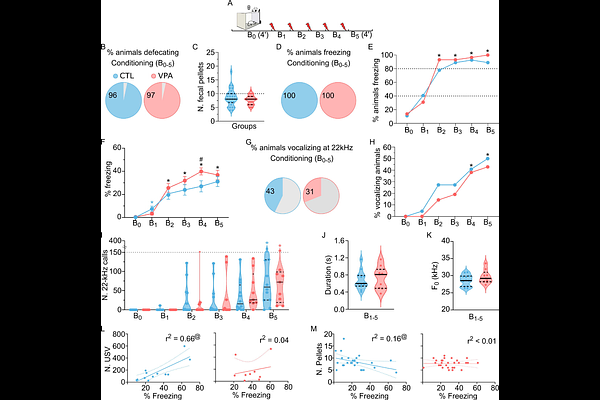Altered Stress and Fear Responses in the VPA Rat Model of Autism: Behavioral Dissociation Across Tactile, Nociceptive, and Social Contexts

Altered Stress and Fear Responses in the VPA Rat Model of Autism: Behavioral Dissociation Across Tactile, Nociceptive, and Social Contexts
HASHIGUCHI, D.; Dias, A. L. A.; Romcy-Pereira, R. N.
AbstractSensitivity to environmental stimuli is a fundamental aspect of human behavior, and its dysregulation is associated with stress-related and anxiety disorders. In autism spectrum disorder (ASD), altered sensory processing may contribute to increased vulnerability to such conditions. To better understand this relationship, we evaluated autonomic and behavioral responses to tactile, nociceptive, and social stressors in juvenile Wistar rats prenatally exposed to valproic acid (VPA), a widely used animal model of ASD. VPA-treated and saline-treated control (CTL) rats underwent a battery of stress-related behavioral tests. Defecation, freezing and vocalization behaviors were analyzed in response to handling, electro-tactile stimulation, nociceptive foot shock (fear conditioning) and social stress stimuli (emotional contagion). VPA-treated rats maintained increased defecation during handling and a higher prevalence of defecation during electro-tactile stimulation, without corresponding changes in freezing. During fear conditioning, these animals showed delayed onset and heightened freezing responses. Furthermore, unlike CTL rats, VPA-treated rats lacked correlations among freezing, defecation, and vocalization. In the emotional contagion paradigm, observation of shock in the partner increased the prevalence of animals freezing and reduced the prevalence of animals vocalizing in both VPA and CTL groups (oV+ and oC+) compared to their respective controls (oV- and oC-). However, these effects were more sustained in oV+ rats, which also exhibited prolonged freezing behavior and an earlier reduction in vocalization rate. These findings indicate that VPA-treated rats display heightened stress reactivity, habituation deficit and disrupted coordination of fear responses, supporting the VPA model as a relevant tool for investigating the neurobiological basis of stress vulnerability and social dysfunction in ASD.